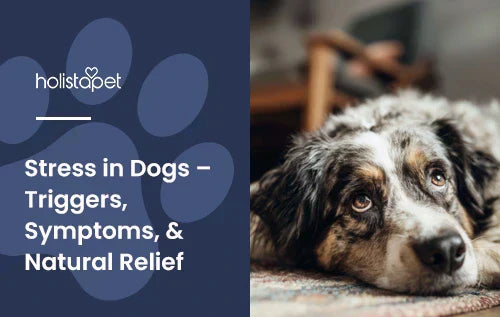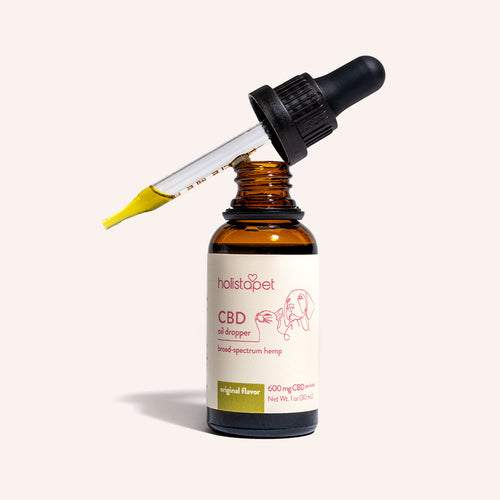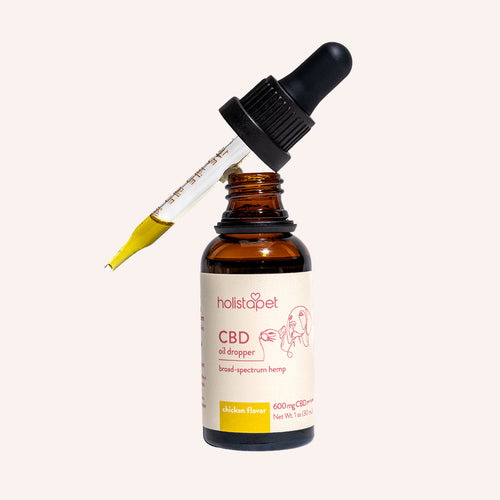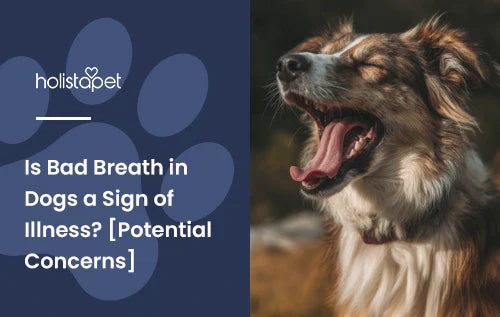Stress in dogs can change how your pup feels, behaves, and bonds with you. At first, you may notice slight changes in behavior or body language that suggest something is off. If left alone, excessive and prolonged stress can lead to much worse issues, like a weakened immune system or a shortened lifespan, to name a few.
Since stress can potentially wreak havoc, it's essential to watch for symptoms and take action if your dog exhibits any stressful traits. The signs can range from slight agitation to clear signals that your dog feels uneasy. The good news is that you can spot triggers, recognize symptoms, and support natural relief.
Do Dogs Experience Stress?

Yes, dogs feel stress just like humans, but it shows up differently. Stress in dogs can impact their mood, energy levels, and daily habits. You might notice anxious behaviors when routines change or new people visit the home. Spotting these signs early helps you understand your dog and step in before stress becomes a bigger problem.
What is Stress in Dogs?
Stress in dogs is a natural response to a perceived threat, sudden change, or uncomfortable environment. Your dog’s body reacts with signals that may affect mood, energy, and social behavior. This stress response may occur suddenly or develop gradually over time. By understanding how it works, you can recognize early warning signs and support your dog’s well-being.
Understanding Dog Stress and Its Impact on Health
When your dog feels stressed, the body releases signals that weaken the immune system and disrupt its balance. This strain can cause your pup to appear sad, tired, restless, or less social. Over time, constant stress affects both comfort and mood. Helping your dog stay calm supports good health and a happier routine.
Why Stress Can’t Be Ignored in Your Pup
Ignoring stress in your dog can lead to more serious behavior and health problems. What may begin as small signs of stress can develop into noticeable behavioral issues or even physical discomfort. Long-term stress also lowers immune response, making your pup more vulnerable. Over time, this constant strain can affect sleep, digestion, energy, and overall health, leaving your dog less resilient and more unsettled.
What Causes Dogs To Feel Stress?
Dogs can get stressed for many reasons. Sudden noises, changes in routine, or social conflicts can trigger quick reactions. Health issues or poor environments may also add pressure. By knowing these triggers, you can support your pup better and cut down stressful situations before they build up.
Environmental Triggers
Loud sounds like fireworks, thunder, or shouting can trigger dog stress symptoms fast. Travel, vet visits, or crowded places may also cause nervous behaviors. Even strong smells from smoke, cleaning products, or perfumes can lead to agitation. Also, watch out for flashing lights, construction noise, or sudden temperature changes.
Separation Anxiety and Routine Changes
Being left alone for long hours can cause fear of separation and negative thoughts in dogs. Changes in feeding, walking, or sleep schedules may throw off your pup’s routine and bring on anxious behaviors. Even a new baby or roommate in the home can trigger stress. Vacation departures, moving furniture, or shifts in work hours also unsettle sensitive dogs.
Social Stress
Meeting new people or other dogs can make a stressed dog bark or avoid contact. Crowded dog parks or moving to a new home can cause tension that makes dogs feel stressed. Some dogs show worry by licking their lips, pacing, or cowering. Visits from unfamiliar family members, loud gatherings, or potential conflicts with other pets can also raise stress levels.
Physical and Health-Related Stressors
Dogs can feel stressed from aches, soreness, or health problems. Poor nutrition, sudden diet changes, or little exercise can also cause irritation and low energy. Older dogs often exhibit more stress when health declines or mobility issues emerge. Balanced nutrition and regular activity help ease discomfort and keep dogs calmer.
Sensory Overload and Mental Stress
Excessive stimulation at home, like loud TV, music, or kids playing, can overwhelm your pup. Without brain games or playful activities, dogs may store up extra nervous energy. Dogs lacking enrichment often show agitation or restless behavior. Creating balance with calm spaces and engaging activities helps reduce stress and support emotional stability.
Recognizing Dog Stress Symptoms
You can spot stress in dogs by watching their body language and daily habits. Some signs appear obvious, while others show up as subtle cues that owners often miss. A stressed dog may act restless, show physical discomfort, or change behavior patterns. Learning these stress signs helps you respond faster and create a treatment plan that restores balance and calm behavior.
Physical Signs of Stress
A stressed dog often shows clear physical signs, such as shaking, panting, and digestive issues. You might also see raised hackles or redness around the ears during stressful moments. Other common signs include drooling, excessive shedding, changes in appetite or weight, or trembling during loud events.
Behavioral Signs of Stress
Changes in behavior are often a sign that a dog is stressed. These may include pacing, whining, and hiding in quiet spaces. Aggressive behaviour, like growling at other dogs or people, may also appear during stressful situations. Your dog’s body language, such as avoiding direct eye contact, provides clear clues. Excessive barking, sudden destructive chewing, or refusal to eat may also indicate stress.
Subtle Stress Cues Owners Often Miss
Some stress signs in dogs appear so small that they slip past many people. Lip licking, yawning when not tired, or raised hackles during calm moments can signal discomfort. Shifts in posture, like a tucked tail or stiff stance, also reveal stress. You might also overlook signs like pinned ears, frequent paw lifting, or sudden shedding during tense moments.
What Stresses Dogs Out the Most?
Many dogs get stressed by loud noises, sudden changes, or new places. Tension with other dogs or family members can add to that stress. Puppies and older dogs often react more strongly. By spotting what triggers discomfort, you can create a plan that helps your pup stay calm and balanced.
How Individual Dogs React Differently
Each dog handles stress differently. Some bark or pace, while others hide from family members. Puppies may whine, and senior dogs often show reduced mobility or irritability. Genetics, environment, and past experiences all play a role. Changes in your dog's behavior vary because every dog is different. They process stressful situations through their own unique mix of temperament, learning history, and daily routine.
Short-Term vs Long-Term Dog Stress
Acute stress comes in quick bursts, often triggered by sudden noises or changes. It usually fades once the threat is gone. Chronic stress develops slowly and has a stronger effect on health and behavior. Over time, it can weaken the immune system and cause health issues. Knowing the difference helps you respond better and protect your dog’s well-being.
Immediate Reactions to Stressful Situations
When a dog feels stressed, the body shows clear signs right away. Shaking, pacing, and barking often happen during loud noises or tense moments. Raised hackles and shifts in body language also reveal the stress response. These signs usually fade once the dog feels safe again. Spotting them early allows you to calm your pup before stress turns into bigger issues.
Natural Ways to Calm Dog Stress
You can help ease stress in dogs with simple, natural methods. Regular exercise, play, and mental stimulation keep them calm and balanced. A safe space with comfort tools reduces anxious behaviors during tough moments. Wellness or CBD products may also support emotional balance. Using these options together creates a stress plan tailored to your dog’s needs.
Exercise and Mental Stimulation
Regular exercise helps dogs release energy and ease stress. Walks, playtime, and activities like fetch or agility bring movement and joy. Puzzle toys or training sessions add mental stimulation and keep their mind active. These habits encourage calm behavior, boost mood, and lower anxious behaviors linked to boredom.
Calming Environments and Comfort Tools
Creating a calm space helps your dog feel safe during stressful situations. A quiet corner with soft bedding or familiar scents can ease agitation. Comfort tools like chew toys, weighted blankets, or soothing sounds reduce anxious behaviors. These supports guide your pup back to calm behavior and lower stress levels. Small changes at home can have a significant impact.
Herbal & Supplement Support for Stress Relief
Natural additions to your dog’s wellness routine may help alleviate stress and promote calm behavior. CBD products, calming herbs, or melatonin chews can support emotional balance in anxious dogs. These therapeutic options work best when combined with exercise and comfort tools. Choosing the right option for your pup’s needs creates a more effective stress management plan that fits daily life.
Holistapet Calming Options for Dogs

Holistapet offers calming products that support your dog during stressful situations. These options may help lower stress levels and encourage steady, calm behavior.
- CBD Dog Treats and Chews - Infused with premium CBD, these tasty snacks may help ease tension, promote relaxation, and fit seamlessly into your dog’s daily routine.
- Melatonin Dog Chews - A natural way to calm nerves and encourage restful sleep, especially for dogs dealing with separation anxiety or nighttime restlessness.
- CBD Oil for Dogs - Offers flexible dosing for personalized support, helping manage stress, promote balance, and keep your pup calm in a variety of situations.
Probiotics and Gut Health for Stress Management
Did you know that gut health may affect how dogs handle stress? A balanced digestive system supports healthy immune function, which properly with daily stressors. Probiotics help keep this balance, potentially making stress more manageable.
Probiotics may help calm dogs by supporting the gut-brain connection, which can lower stress hormones like cortisol and ease anxious behaviors. Adding them as a natural remedy to your dog’s routine may boost mood, energy, and well-being while supporting calmer behavior over time.
How Gut Balance Impacts Dog Stress Levels
A healthy gut helps manage your dog’s stress response. When digestion runs well, the immune system stays strong, and the mood stays steady. Poor gut balance can raise stress and lead to anxious behaviors. Probiotics may aid digestion, support nutrient absorption, and promote overall wellness. Protecting gut health gives your pup the defense to handle stressful moments.
Holistapet Probiotics for Dogs as a Supportive Option
Holistapet Probiotics For Dogs Soft Chews support digestion and may help with stress management. They promote gut balance, which boosts immune function and supports emotional response. Adding them to your dog’s routine can ease anxious behaviors and lower stress. With regular use, these chews encourage calm behavior and serve as a natural boost to overall wellness.
When to Seek Professional Help
Sometimes a stressed dog needs more than support at home. If signs keep showing up even after positive changes in routine, outside help may be needed. A veterinarian can check for causes of discomfort, while a trainer or behaviorist can guide a plan for anxious behaviors. Getting help at the right time protects your pup’s health.
Situations That Require a Veterinarian
You should contact a veterinarian if your dog’s stress signs become severe or persistent. Ongoing digestive issues, significant changes in behavior, weight loss, or refusal to eat may signal an underlying medical condition. A vet can run tests, rule out health problems, and suggest a treatment plan. Acting early helps protect immune function and reduces the risk of long-term discomfort or agitation.
Role of Professional Training or Behaviorists
A professional trainer or behaviorist can guide both you and your dog through stressful situations. Using positive reinforcement, they teach calm behavior and reduce aggressive behavior linked to stress. Their expertise in animal behavior helps uncover subtle signs and underlying causes. Training builds confidence in anxious dogs and improves their daily routine. This outside support strengthens your bond while managing stress levels.
FAQs – Stress in Canines
How do I know if my dog is stressed?
You can tell if your dog is stressed by watching for changes in body language or behavior. Signs include pacing, whining, shaking, or avoiding eye contact. Subtle signs like lip licking or raised hackles may also show stress.
Can stress make my dog sick?
Yes, stress can affect your dog’s health over time. High stress levels may weaken immune function, cause digestive issues, or reduce energy. Chronic stress often increases discomfort and leads to behavioral problems.
Do calming treats or supplements really work?
Yes, calming treats and supplements can support stress management in dogs. CBD chews, melatonin, or probiotics may reduce anxious behaviors. These work best when combined with exercise, enrichment, and a balanced daily routine.
How long does dog stress usually last?
Stress in dogs may last a few minutes or continue for days. Acute stress fades quickly once the perceived threat ends. Chronic stress lasts longer and requires a treatment plan to manage symptoms and restore balance.
What’s the difference between anxiety and stress for dogs?
Stress in dogs comes from a direct trigger, like a loud noise or social conflict. Anxiety in dogs often develops without a clear cause and may linger longer. Both affect behavior, but stress usually ends when the trigger is gone.
Final Thoughts on Why Dogs Feel Stress and How to Help
Stress in dogs is real, but you can help your pup live with more comfort and calm behavior. Pay attention to stress signs, respond quickly, and build a daily routine that supports balance. Fun activities, wellness products, and positive reinforcement all make a difference. For natural relief, Cheef Botanicals offers trusted options that fit easily into your dog’s lifestyle.


 CBD Oil for Dogs - Fast Acting
CBD Oil for Dogs - Fast Acting
 Chicken Flavored CBD Oil For Dogs - Easy Dose
Chicken Flavored CBD Oil For Dogs - Easy Dose
 Salmon Flavored CBD Oil For Dogs - Highly Rated
Salmon Flavored CBD Oil For Dogs - Highly Rated
 CBG Oil for Dogs and Cats - Loved by Thousands
CBG Oil for Dogs and Cats - Loved by Thousands





Leave a comment
All comments are moderated before being published.
This site is protected by hCaptcha and the hCaptcha Privacy Policy and Terms of Service apply.